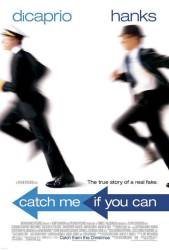Factual error: On the plane, while being escorted by FBI agents, Frank Jr sees New York's LaGuardia Airport and says, "There it is, LaGuardia Airport, runway 44." A runway numbered 44 is impossible. No runway can be numbered over 36 because there are 360 degrees in a circle. (01:58:25)

Catch Me If You Can (2002)
Plot summary
Directed by: Steven Spielberg
Starring: Tom Hanks, Christopher Walken, Amy Adams, Leonardo DiCaprio, Martin Sheen, Nathalie Baye
Frank Abagnale, Jr. worked as a doctor, a lawyer and a co-pilot for a major airline—all before his 18th birthday. A master of deception, he could assume nearly any identity. Frank was also a brilliant forger, and by age 17, became the most successful check forger in U.S. history. FBI Agent Carl Hanratty has made it his primary mission to capture Frank and bring him to justice, but Frank is always one step ahead.
Frank Abagnale Jr.: Ah, people only know what you tell them, Carl.
Trivia: Frank Abagnale's father was, in real life, a straight honest law abiding citizen, and not the shonky con-man as depicted in the movie.
Question: I may have missed this, but why does Frank tear the labels off bottles?
Answer: He does it so he will have things in his wallet. As he has no identity of his own and steals or creates others, filling his wallet with labels is fulfilling a subconscious desire to be normal and have an identity.
Join the mailing list
Separate from membership, this is to get updates about mistakes in recent releases. Addresses are not passed on to any third party, and are used solely for direct communication from this site. You can unsubscribe at any time.
Check out the mistake & trivia books, on Kindle and in paperback.




Answer: He was taking the labels off the bottles to make fake checks, using the logos as this is the one thing that he could not create on the checks. The MICR printer was only used to print the routing and account numbers and the emboss the checks.
This is incorrect. Frank exclusively makes Pan Am checks until his arrest in France. A logo from a ketchup bottle or peanut butter jar would be far too large for a check. Instead, as shown, Carl examines Frank's wallet, which is filled with labels taken from various items—supporting the more accurate explanation provided in the other answer.
jshy7979